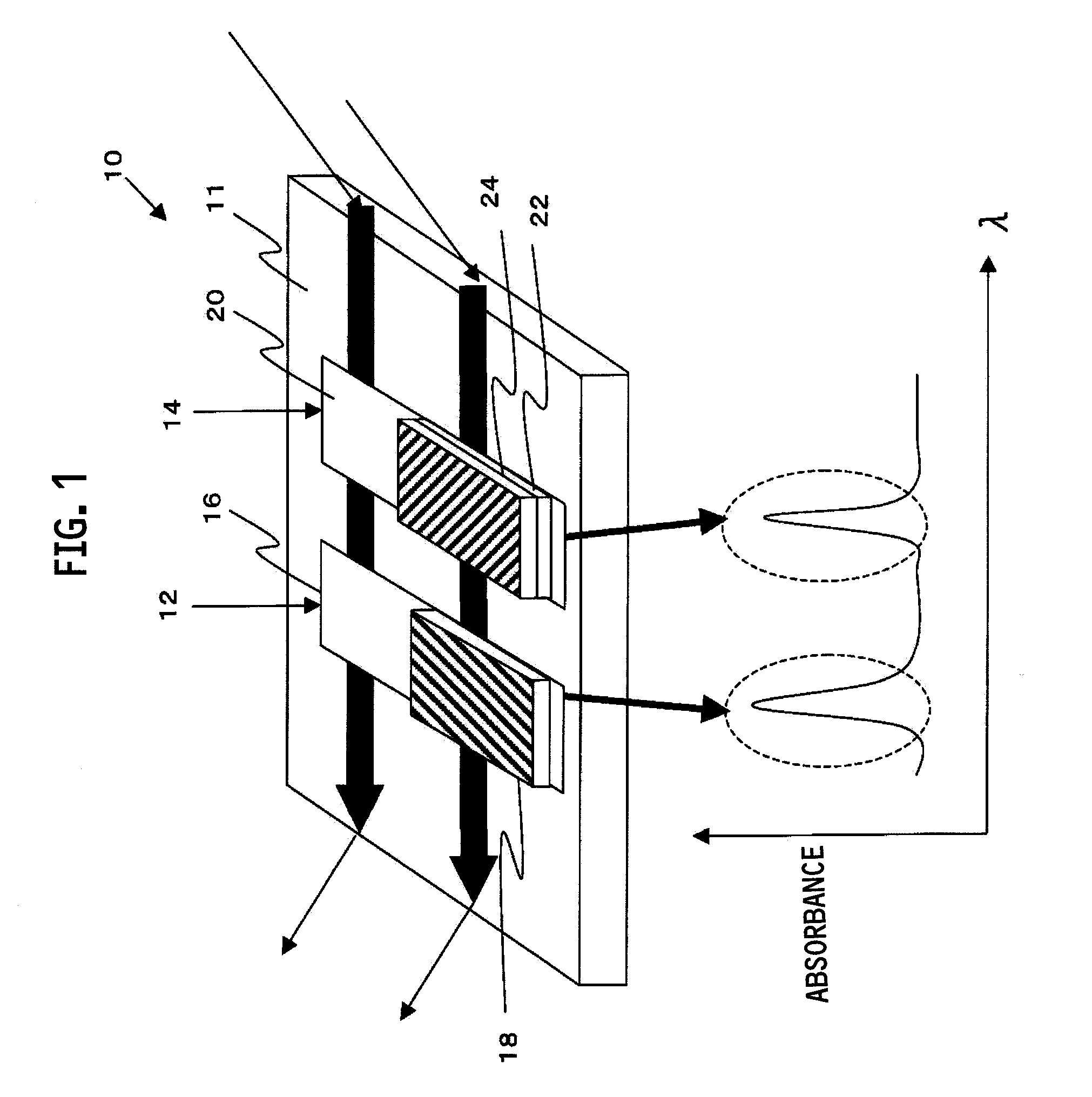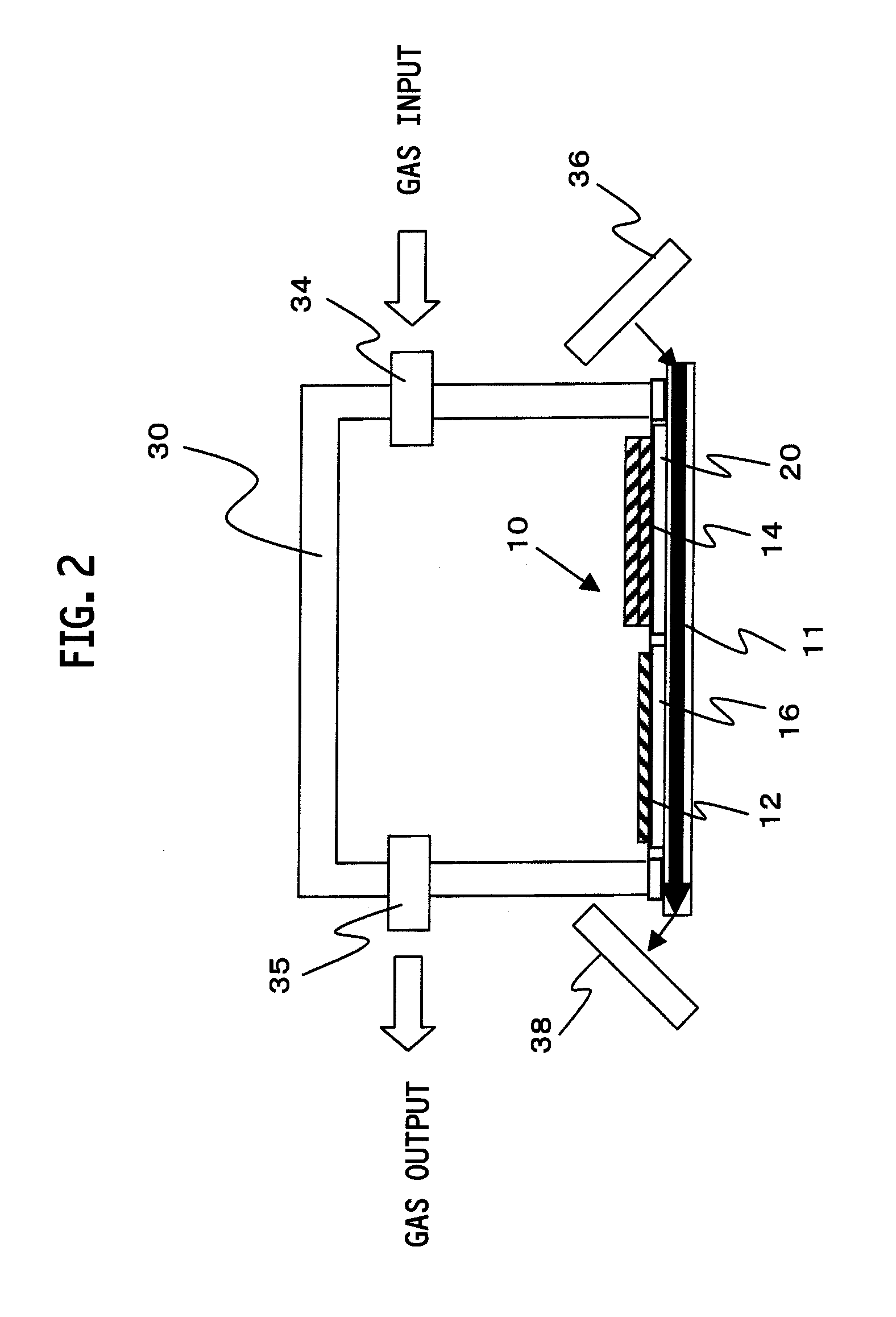Spr sensor
a sensor and sensor technology, applied in the field of sensors, can solve the problems of large size, further increase in size, and difficulty in achieving both miniaturization and multichannel detection of such a sensor, and achieve the effect of low cost and simple structur
- Summary
- Abstract
- Description
- Claims
- Application Information
AI Technical Summary
Benefits of technology
Problems solved by technology
Method used
Image
Examples
example 1
[0158]First, a slide glass (26 mm×26 mm) was prepared as a transparent substrate. Then, a 50-nm-thick layer made of Ag was formed as a metal layer on the slide glass by vacuum vapor deposition. At this time, the metal layers (7 mm×18 mm) were formed in two regions for use as detection regions by using a mask so that no metal layer was formed in a region other than the two regions. Then, as shown in FIG. 1, a 10 mg / mL PVK solution (solvent: toluene) was applied onto one-half of the surface of one of the two metal layers by a casting method to form a 20-nm-thick dielectric constant regulation layer (sensitive layer). On the other hand, a 100-nm-thick MgF2 layer was formed by vacuum vapor deposition on one-half of the surface of the other metal layer, and then a 20 mg / mL PVA solution (solvent: pure water) was applied onto the MgF2 layer by a casting method to form a 10-nm-thick sensitive layer so that a dielectric constant regulation layer composed of the MgF2 layer and the PVA layer w...
example 2
[0160]Metal layers were formed in two regions on a slide glass in the same manner as in Example 1. Then, a 20 mg / mL PVA solution (solvent: pure water) was applied onto one-half of the surface of one of the two metal layers by a casting method to form a 10-nm-thick dielectric constant regulation layer (sensitive layer). On the other hand, a 90-nm-thick MgF2 layer was formed by vacuum vapor deposition on one-half of the surface of the other metal layer, and then a 6 mg / mL PMMA solution (solvent: acetone) was applied onto the MgF2 layer by a casting method to form a 10-nm-thick PMMA layer (sensitive layer) so that a dielectric constant regulation layer composed of the MgF2 layer and the PMMA layer was formed.
[0161]Then, a detection device such as one shown in FIG. 2 was produced in the same manner as in Example 1. Then, dry nitrogen passed through silica gel, wet nitrogen obtained by bubbling nitrogen in pure water, and toluene-nitrogen obtained by bubbling nitrogen in toluene were int...
example 3
[0162]Metal layers were formed in two regions on a slide glass in the same manner as in Example 1. Then, a mixture of a 5 mg / mL PVK solution and a 10 mg / mL octadecane solution (solvent: toluene) was applied onto one-half of the surface of one of the two metal layers by a dip coating method to form a 40-nm-thick dielectric constant regulation layer (sensitive layer). On the other hand, a 100-nm-thick MgF2 layer was formed by vacuum vapor deposition on one-half of the surface of the other metal layer, and then a 10 mg / mL PVA solution (solvent: pure water) was applied onto the MgF2 layer by a dip coating method to form a 55-nm-thick PVA layer (sensitive layer) so that a dielectric constant regulation layer composed of the MgF2 layer and the PVA layer was formed.
[0163]Then, a detection device such as one shown in FIG. 2 was produced in the same manner as in Example 1. Then, dry nitrogen passed through silica gel, wet nitrogen obtained by bubbling nitrogen in pure water, and toluene-nitr...
PUM
| Property | Measurement | Unit |
|---|---|---|
| thickness | aaaaa | aaaaa |
| thickness | aaaaa | aaaaa |
| dielectric constant | aaaaa | aaaaa |
Abstract
Description
Claims
Application Information
 Login to View More
Login to View More - R&D
- Intellectual Property
- Life Sciences
- Materials
- Tech Scout
- Unparalleled Data Quality
- Higher Quality Content
- 60% Fewer Hallucinations
Browse by: Latest US Patents, China's latest patents, Technical Efficacy Thesaurus, Application Domain, Technology Topic, Popular Technical Reports.
© 2025 PatSnap. All rights reserved.Legal|Privacy policy|Modern Slavery Act Transparency Statement|Sitemap|About US| Contact US: help@patsnap.com



